Gems That Go Unnoticed
There are not many craft and woodworking shows I visit that surprise me with gifted makers. By that, I don’t mean gimmicky presenters with a gift for quickspeak but more the ordinary artisans who actually capably make with skilled hands and deft fingers in different crafts. At the Henley Country Craft Show at Stonor last weekend I found only a few people crafting that produced impressive work. Signs dotted around the tent walls said “Meet the Makers” but in some cases, jewellery for instance, and some leatherworkers, the signs might better have read Meet the Assembly Workers or more still Meet the Importers. But there were potters galore, and a basket weaver making baskets of different types from willow he grew himself for harvesting and making into dyed baskets. Spoons are a repeat performance for spoon carving with axes and profiled knives from soft and green hardwoods and sometimes you will see someone really gifted but not so much on this visit. No, there were many kit sellers selling gear like marbling kits, wood block stamps laser cut for you to stamp your own fabrics with their designs and such. These were machine made cookie cutter type stuff and not much to do with hand making and craft. Actually, most of that side of things replaced the need of craft skills more than anything.
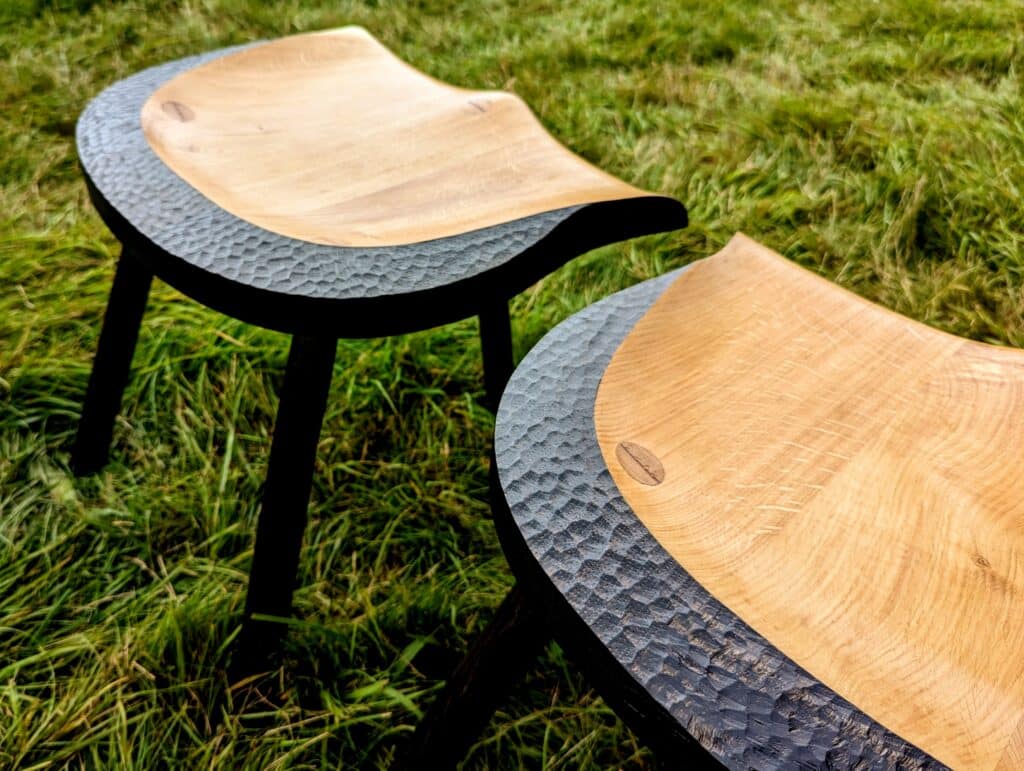
Going this time made me aware of some of the dynamics making shows happen. Half of the booth or stall holders were selling food, which was good, needed and of course, expected. Some of the foods they made and sold themselves and some looked bought in. It was mostly about there and then cooking on a hot plate. The delicious gourmet food booth sold ordinary burgers which stretched the description of the food title to be much longer than the booth sign and then some. I bought some delicious homemade Greek food that came from a small bakery in London owned by two Greeks. The price was good and well worth my lunch allowance––I was working. Looking for artisan artists these days is mostly the needle-in-the-haystack search. I found three that met my criteria in the 100 or so exhibitors. But there was an entertainment value in the others and this leads me to say what the dynamics are that make a craft show work.
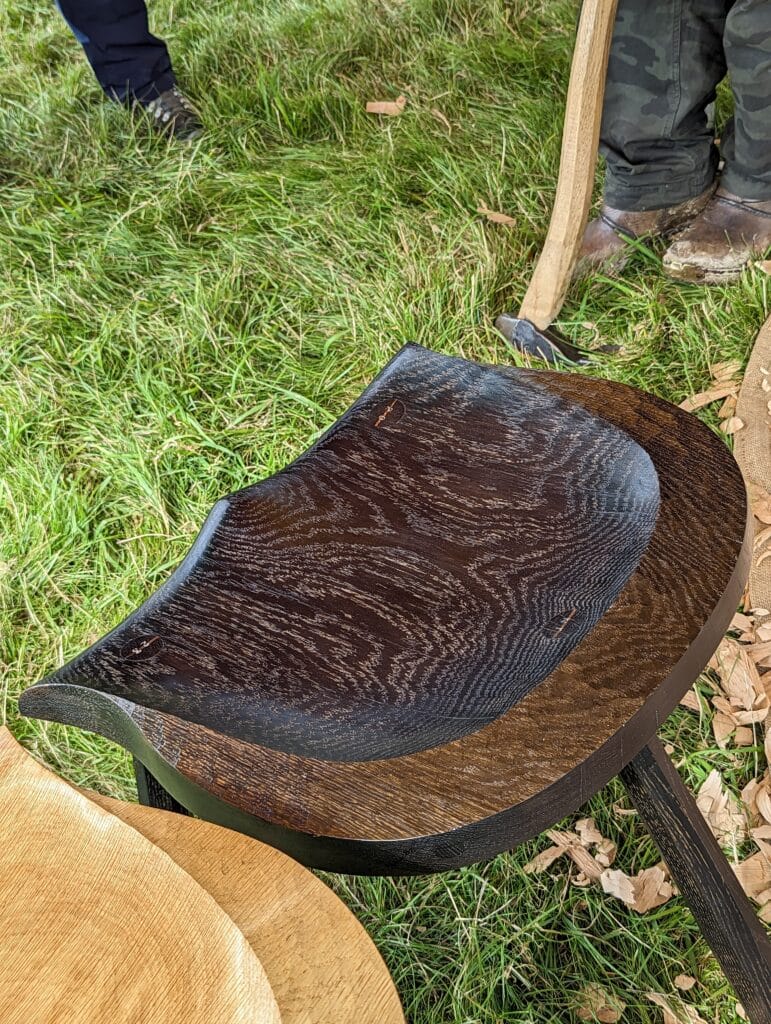
The venues for craft shows of any size are often country homes; former mansions owned by the rich and privileged. Fields holding sheep the week before suddenly have parking lanes and tent pitches hosting overnighters and daytime visitors to the show. This July and August have been clouded by more enjoyable cool weather with a goodly amount of rain and zero hosepipe bans. Not like other parts of the globe with horrendous weather conditions, fires and more. Having lived in Texas for two decades I am now more leery of traveling anywhere where heat and sun are the draw. In this case, the Mansion home of the Lord and Lady of the house is a pleasant place to be. Nestled in the traditionally quiet rolling hills, the tents enjoy levels of pastureland that allow for the booths to be neatly situated for a pleasant two-hour walking tour. Surprisingly, I did not really find any truly wowing factors beyond Neil Taylor making his chairs and stools. More on that in a minute.
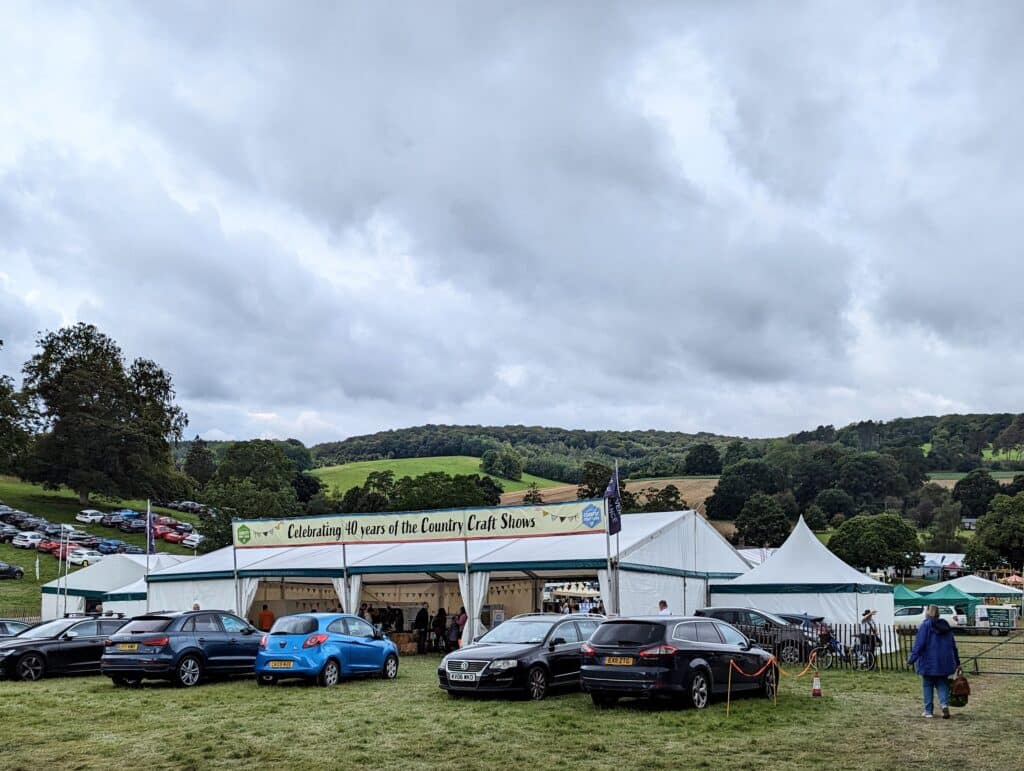
Here is what I want to say: Craft shows offer different dynamics surrounding mostly entertainment. Booth holders hope to make sales but their goods offer interesting things to look at as well as gifts for different seasons. Though the shows have become entertain-me venues they are also meeting centres for young families to get together and share some open space. With several sources of income possible, there is always a degree of commerce taking place somewhere, mostly surrounding children’s play areas and always around food. Let’s look at the main venue provider first. Whether they own or rent the space from an owner, there are several sources of income available to them. One, they rent the booth spaces from the vendors selling their goods. Let’s say the booths sell for £100 and there are, as in this case, 200 booths. That brings in £20,000. Then there are campsite fees for tents, touring vans and such. It’s cheaper than a hotel or Airbnb, usually. Then there are the entry fees to the show. This can go to the venue owner or the renter of the venue space as in the show promoter renting the field, etc. At £10 per person, the entry fee is reasonable and the facilities are good too. Who knows how many visitors there will be over the four-day event? Let’s guess at 20,000 and it’s likely to be more so there’s another £200,000. What the overheads to be deducted from the £220,000 are remains unknown but tents and decent portable bathrooms, power rigs for electricity, etc don’t come cheap. Of course, there is a year-round overhead for the property owners or managers. These weekends might bring in a good pot of gold but if the weather fails them they may well take a loss too. It’s swings and roundabouts and I would not wnt the headache of it. I was involved in a craft venture and venue for two decades in Central Texas once a year and had many a sleepless night for weeks beforehand.
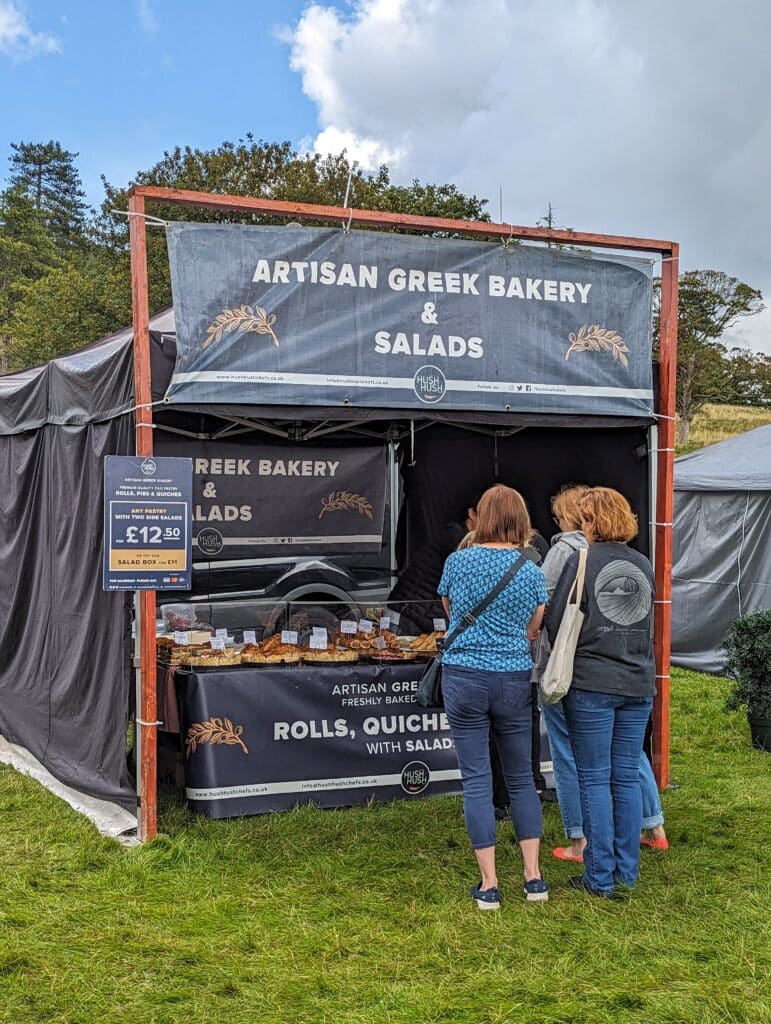
The entertainers are mainly the booths and booth holders hoping to make a sale somewhere in the day and of course, these guys pay for their venue so they are generally low demand, low cost, low maintenance and self-policing so not too much of an overhead for the venue holder.
The venues within are places of low-cost entertainment for families on a holiday weekend. This weekend is one of our usual eight UK Bank Holidays. I’m still not sure why they are called that and not just like, well, break days or holidays. We also have one or two other days such as Royal celebrations and so on. But anyway, I was entertained watching caterers cater food and drink to families and drinkers who took ten seats with four occupied and the remainder reserved for children who disappeared to the children’s entertainment areas whilst lunch eaters stood on the periphery of the tent dodging the rain dripping off the marquees onto their tofu burgers and salad and trying to slice impossibly with a wooden knife with saw teeth 3mm wide.
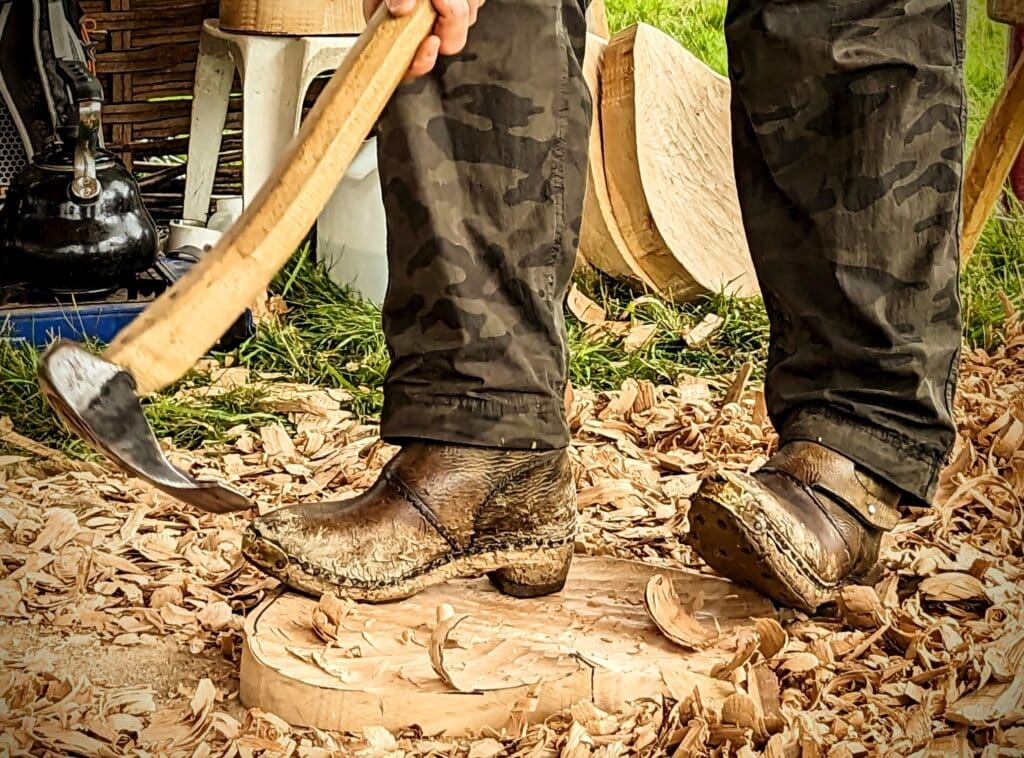
But when I saw Neil standing adzing his next stool seat my sanity was saved. What a breath of fresh air. He’s a like-minded lifestyle woodworker going against the industrial tides as much as he is able. We first met ten years ago at a wood festival where we both exhibited and felt a kindred spirit. Ten year’s ago that show had dozens of crafting artisans striving to live an alternative lifestyle. Many makers there to share space and time with. It’s nice to meet like this. I didn’t know he would be there but I hoped he would be. It’s not too easy having an intelligent conversation with people trying out chairs for fit but we exchanged a few sentences with each other. Few people can hack it making and selling from rough wood to a finished sale at venues like this these days. Possible buyers jockey with the idea without quite realising that £1,200 is not really a lot to pay for something so hand-hewn as a large chair with bent backs, adzed seats and drawknifed legs and spindles finished off unturned with a spokeshave. One day I will buy one of his chairs. Better do it soon.
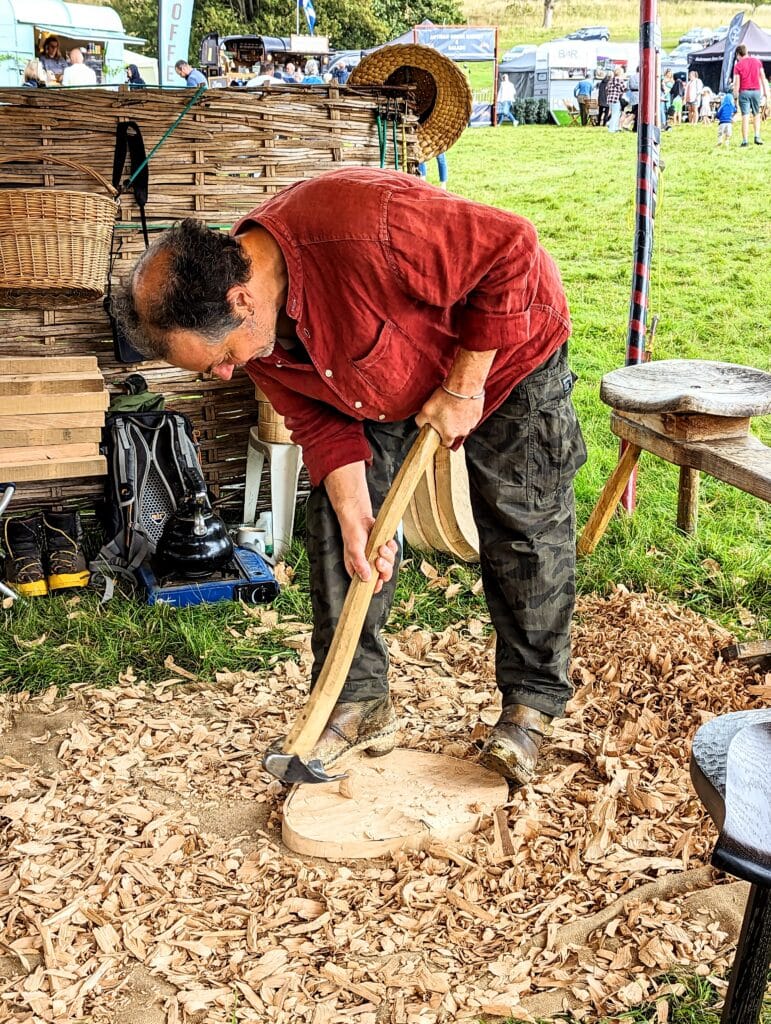
Neil is married and has two newly adult sons entering the world of work. They have not followed in Neils’s steps and with good reason. Like most children of artisans, they saw how hard it was to work making and then invest all you have in a few weekend shows knowing the weather and people can be fickle. Being gone at weekends for a few seasons is fine but soon they develop their own passages into adult beings.
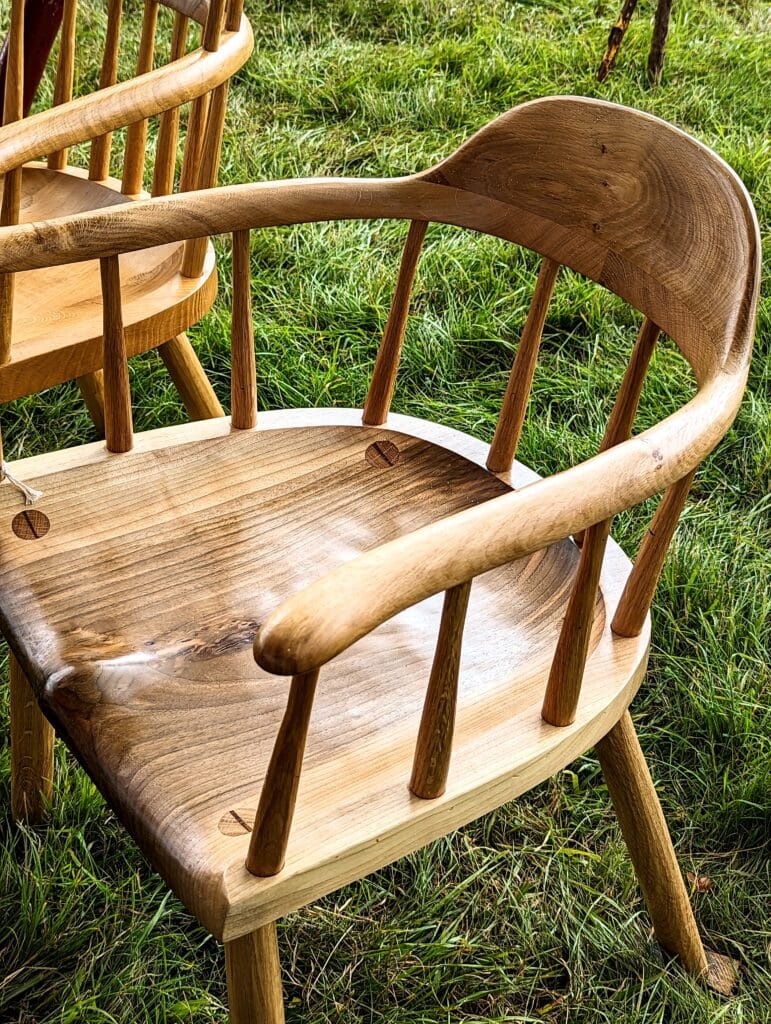
Watching Neil from the wings, him quietly and methodically chipping away at an oak seat with an adze, made me wonder why a hundred people weren’t standing there watching and admiring him too. He’s not just skilled but remarkably so. How often can anyone walk anywhere and see a man carve a seat with an adze or strip the excess from a stave to make and shape legs and rails? People walked past eating food and drinking coffee or prosecco as if he didn’t even exist. Not quite everyone but almost. How is such a thing possible? Of course, it’s not as impacting as the buzz of chainsaws and men in chaps and hi-viz gladiator gear. I get that. But the steady progress and the swing of an adze are not slow at all and there are skills in both camps. Still, adze work is not like the man with the chainsaw taking off chunks in seconds to rough out a bear or an owl from a wooden stump. He had it roughed down in ten minutes and everyone clapped even though it still had a way to go. Neil’s heirloom pieces will be around in 300 years’ time, I have no doubt. The bear? Well, it is quite novel and entertaining but passing.
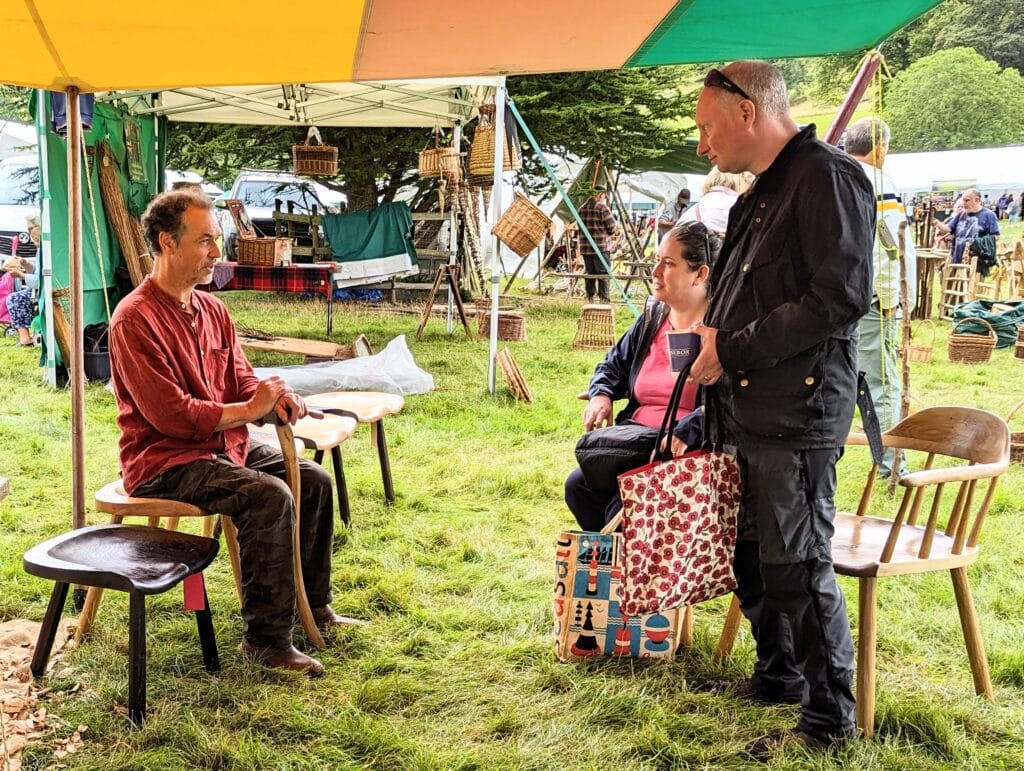
There is always a certain distinctiveness with Neil––I think I would best describe it as the humility of a man who discovered his calling and then had the humility to follow it decidedly, with certainty and a sense of having found himself. Few people in our day would regard the man as having what they might call ‘a real job‘ though, of course, very real is because what he might describe as his passion I would more actively and even provocatively describe it as his calling because I believe in callings be they vocational or whatever. There is no diminished accountability for naming it so. We all have one. We usually fail to follow it because, well, we have too many distracting influences not the least of which could be the highest bidder offering us a job or an unhearing parent who cannot believe their children can indeed decide for themselves. The certainty I feel being in the same space with Neil is what I feel when I am making but one I rarely feel with others selling at craft shows. There is a certain confidence in the man that sits squarely alongside his inner calm. Most men in his shoes would likely never survive the unknowing future of being a crafting artisan maker that comes with the territory. You only get it when you’ve lived it, relied on it, understood the reason for it. Getting off of the expectational conveyor belt most are carried along by is not so easy. others expect that one day you will see the light and get a real job somewhere in industry doing something like fitting and hanging doors using some power equipment or maybe working in a big box store, such like that. But, well, not everyone is meant to do that and neither do I see Neil in some reenactment museum being mused over by people dressed in the garb for entertainment. Don’t get me wrong, some will enjoy that and it’s entertaining. But for Neil, it’s more the meekness of his controlled inner strength that carries him along in his vibrant lifestyle. You seldom see this at craft shows. people cannot see the realness of the man or the woman who takes themselves off of the conveyor belt to live an alternative reality as best they can. Neil isn’t looking to be admired. No, admiration is not his thing at all. he just found peace in being him as a maker. The few who took time to sit with him, who sought him out, well, they got it.
The Neil gems in this world are rare discoveries. You don’t find them often at all. Humility and skill have no gimmicks and there is nothing sensational about them even though their work merits our total attention for however long we can give it. I hope one day to interview more such artisans before they finally disappear. And don’t anyone dare try to tell me they won’t eventually disappear. They will.



This reminds me of a visit to the chair making museum in High Wycombe. The people used to work in the woods. One making legs on the pole lathe. Another making seats with the aze and another maling spindles.They were assembled in the local factories. Appartently most of the people making seats had lost a toe or two.
Adze-Stop probably had not been invented yet 😉
Yes. You’d want steelworker boots with the steel toe box and metatarsal guards, wouldn’t you!
There is a trend in some (i stress the some) craft fairs I have witnessed over the past 15 years or so. An increase in food outlets at many seem to have really changed the dynamic of what is there. A good example is the markets held at Christmas in Manchester. I know someone who has sold their hand made items at that market for over 20 years. It was originally advertised as a craft market with a German theme and always had a mix of foods (both ready to eat and more specialist take home) and crafts. Over time more ready to eat food outlets and an increase in bought in items has taken over from the more artisanal hand made items (including locally made foods).
One theme I have noticed is often perceived value. Visitors shocked at the price of a handmade wooden item that can be personalised for them at the point of sale, but happily eating a sausage and glass of gluhwein which has essentially just been bought from a supermarket and had its price substantially increased
I haven’t been to a woodworking show in years for the reasons you described.
The last time I went there was almost no handwork being done except for the half dozen pen turners. I didn’t know you could rough out a seat with an adze in such a short time. I’m going to investigate that skill set.
Yes, even ther pen turners weren’t there. Of course, you can buy some dynamic pens using the same principles on Amazon and eBay these days. For less than the component part costs if you are a pen turner.
Beautiful article. Thank you Paul
I’ve been to countless fairs/shows like this and you are spot on. Very few, what I would call true craftsman, appear anymore. Everyone is a “maker” now as you’ve described. But to simply watch their methods of work, is awe inspiring. I’ve not seen many use a long handled adze, but I like leverage it seems to provide. To look at his boots, even as skilled as he is, you know that leather has saved several of his toes. Thank you for your insights.
We have had Medievel Festivals here in Vancouver Canada and we have attended them on and off. Food and entertainment were good and some friends were competing in the long bow shoot off. Hand made leather items and some basic woodwork items along with a sword merchant. We have Farmers Markets every week in the summer when the weather is better and some home grown meats as well . Regardless our draw is hand made stuff and we always enjoy the shows. A Craft Fair has been running for about 10yrs now and there used to be a Woodworkers Show a little farther out but that died a few years back. Sadly a lot of people are wandering around looking at their phones.
I gave up on Craft Fairs a long time ago. There was seldom any craft work going on and the events appear to be a series of stalls selling bought in goods. Perhaps ‘Craft Market’ would be a better title for these events. However, it does mean I’ve missed out on witnessing the occasional true craftsmen such as Neil at work, so thank you for your blog and maybe I’ll venture out to a few after all.
Paul. Don’t wait. Buy one of Neil’s chairs soon.
I formed a seat for a windsor chair, with an adze, several years ago. It is satisfying to see it finished in our house. I don’t recommend the process wearing tennis shoes as I did !
Paul, I dare to tell you that crafting and making as you describe will never disappear! The system that we live in today will disappear but never the spirit of making with your own hands. You are happily mistaken!
A lovely read and great to hear that there is a few genuine craftsmen like yourself still around
Thank you Paul for the fine article. I know somehow, perhaps a miracle that at least some true artisans will carry on throughout the ages. There is the sense of connection with humanity and for me sanity to work with basic hand tools. Prior to discovering you on u- tube, I had no idea of hand tool woodworking and am a better person for having discovered what you have shown. Your gifting of yourself, your time, effort and sacrifices for anyone who would listen WILL Live be ON Paul. I do not know how but I am convinced …. heart and soul. Blessings.
Thanks Paul.
In what capacity were you working at the event? You had mentioned lunch allowance and it sounded as if you were working this event. I might have misread what you said.
My going to work is different to most. I ‘volunteer‘ into my days. Nothing and nobody forces me to go to work no matter what my work is be it gardening, writing, designing or making. When I go to the cafe first thing my friends use terms like, “Oh well, better get to work.” or, “Thank God it’s Friday!” “Ah! Weekend at last!” I have no such days or feelings and haven’t had for almost the whole of my life. It actually took me a while to understand them and what they were saying. I have no so-called Monday-morning feelings though I might have events where there are a lot of people talking at the same time that might possibly give me a similar feeling but I really don’t have a way of comparing. I stop work when my body or my mind is too tired to work. I eat when I am hungry. My day works in accordance with the needs my body dictates, hence I eat two regular cooked or uncooked meals a day and really no snacks in between though I might have some nuts or something now and again. I enjoy veg smoothies and also juicing veggies with apple and carrots, hat sort of thing. Anyway, whatever I do suits me as I am never hungry and my day starts at around 6am and most of what I do is surrounding my working and that goes until somewhere after 7 pm with two half hour breaks for eating. Having said all of that, outside of filming, my days feel regulated and steady whereas I do think most people would feel overwhelmed by the shifts from one task to another. At the show I visited with other crafting artisans to find out about what they made. That’s work. My driving there for an hour is working as I would consider commuting to work as part of my work day if I indeed had a job. Funnily enough I don’t consider cycling to work or for exercise working per se, though perhaps i should. In other words, Joe, my day is not splintered into fractured parts where work is when I have a job and not. It’s all work. My lunch allowance is how much I decide I will spend for a meal that is purely to stoke the boiler and keep me going.
if you havent you should try spicy boiled peanuts. they are a southern delicacy. unless u have a nut allergy then then are a trip to hospital.
Lovely. Thank you.
Totally agree with you Paul. most of the craft fairs I go to are very disappointing, and the real traditional hand crafted items are largely lost to cheap made import’s trying to imitate hand made items. That’s when it hits home about how our real heritage skills are slowly dying. Ultimately it’s all about money and instant gratification, trying to simulate something that is about a thousand miles away from the truth of being handmade. But there are as you say, traditional artisans out there. Finding them is a breath of fresh air but it is becoming more of a task as the years go by.
Regards, Paul.
Well, people seem to be under some illusion that governments and businesses are “Bringing them back.” Of course they are not because they can’t. People say, “The colleges and politicians are talking about all of the new apprenticeships they are creating.” but what they call apprenticeships is nothing to do with craft work. Colleges are of course, incapable of teaching craft at the level we are speaking of though they can put across the basics at an inconsistent level depending on those in the saddle. No, these, from my experience and point of view, are people who rarely lived, survived and thrived in the real world of mastering an art form. If you watch a skilled metal worker form an auger bit by eye and hand in front of you in under five minutes then you will know what I mean. I once heard a college lecturer from a high ranking UK college tell fifteen students in front of me that no one can make a living from furniture making. He was the lead instructor of the furniture college in Oxford. This self-fulfilling prophecy became a reality. Why? Because he was the lead instructor and couldn’t make it because of his perspective. No one is saying it’s easy. You will not own a second home or even a second car, but you can make and thrive if you understand the need to work differently.
Educators to seem to be in the business of seeing to it that everyone is educated to the limit they can stand. I’ve always felt that not everyone is happy being put into that mold by someone else.
It took me 50 yrs to break that mold. I took the path I was pushed into until it seemed the only way I could go.
I really really appreciate the tales from someone who found a path that fit him at an early age.
Thank You.
FYI Central Texas has completed it’s pre-heat.
Does anyone have a link to Neil’s web site, Instagram etc?
Info in the post seems to be consistent with this craftsman:
https://www.neiltaylorfurniture.co.uk/
Hope it helps! ☺️
I think this is the website …
https://www.neiltaylorfurniture.co.uk/
https://www.neiltaylorfurniture.co.uk
This is his website:
https://www.neiltaylorfurniture.co.uk/
It contains a link to his Instagram.
Paul, Here in New England woodworking at craft shows seems to be in as rough shape as you are describing in the UK. Most of the few I’ve seen this summer seem at least partially machine crafted from purchased components and are of the lowest common denominator sort. Oh, and everyone can now make a spoon or cutting board, but they all seem to look the same.
Here in New Hampshire, US. We’re very fortunate to have The League of New Hampshire Craftsman fair ever August. This is a fair where any 8one can’t just rent a booth. the League members are all juried in by peers in their craft wether it be wood working, ceramics, painting….. Really great craftsmanship!
Thank you for this. You very eloquently expressed what I cannot find the words for what I have seen. With the onset of Covid, I stopped doing the few shows I had done in the past and I have not resumed. I sell weekly at a local farm where people come once a week to pick up their produce and some stop and talk.
Paul in you last news email you mentioned diamond Stone lubricant (glass cleaner). Which brand do you use? My reason for asking is, I have bought two brands which result in causing rust on metal surfaces.
I, too, lament the waning of true artisan craftwork. Not just for the quality and care in the finished pieces but even more so for the loss of what I consider the heart of craft, the communion with the work, itself. I recently built a piece for my wife with 72 mortise and tenon joints (lots of slats) and it was one of the most enjoyable times I can recall. The concentration required for final trimming of so many tenons, carefully matching grain directions and colors, all of it pulls me into a world of truly immersive eye/hand work. I’m currently building a stand-alone workbench and the most common question I get from friends is, “Will it be Roubo? Nicholson? Moravian?” The answer, of course if both yes and no to the lot. I’m building a workbench that suits my needs and shamelessly – actually, joyously – taking advice from all those who’ve come before. Today, I will be sharpening and honing a slick for the major tenon shaving and even the sharpening with a handheld puck will be a glad undertaking.
Concession: I’ve never relied on my woodworking to feed family or provide a roof. ‘Quickly’ has never been a required consideration in my efforts. So, while I have zero interest in CNC cutters or the like, I understand the economic pressures that lead folks to use them.
No, my lamentation is not that ‘makers’ more often than not use programmed machines or purchase pre-formed parts, but rather that they will never know the peace and joy that comes with hand work done thoughtfully. Where I live (Olympic Peninsula of Washington State, US), I am surrounded by tall trees, quiet but friendly neighbors and my hand tools. And I love my life. I could go on but don’t want this to become a rant. Thank you, as always for the lovely thoughts and yes, example.
It saddens me deeply that such artisans will disappear. I learned the hard way that “unplugged” craftsmanship has little place in an industrialised economy, it breaks my heart. Craftsmanship will continue, passed on by the lifestyle craftsperson, I am thankful for that (thank you Paul). But watching an artisan like Neil is like watching the last Tasmanian tiger in a zoo cage.
Quite a few years ago I attended a muzzleloading rendezvous. Only one gunmaker was there. His guns may have been functional, but the stocks were clunky as could be. Looked like they had been shaped by a machine. Nothing like the graceful lines of the originals. Thankfully there are still a few craftsmen who still produce some muzzleloaders that look just like the originals.
I was a professional Artist Blacksmith for 20 years or so. It was a continual battle to educate every customer as to what it takes to make a handmade product. People have been conditioned to think that it is better to buy the cheap product 5 times than to pay once for quality. Being a one person shop is very hard, you have to be a marketer, accountant, designer and maker. I got tired of working so hard to make half a living. I ended up closing shop.
Now I am doing some hand tool woodworking as a hobby and love to go into the shop.
This coming weekend, Sept. 8 thru 10 will be the 46th annual Wooden Boat Festival in Port Townsend, Washington USA. There will probably be around 300 wooden boats ranging in size from 120 foot schooners to 10 foot row boats. At least two of the schooners are a hundred plus years old. Many of the older boat have been restored locally in the boat haven ship yard in Port Townsend. All of them are works of art. If any of you are ever in the west coast of the USA in the fall, it is a sight to see.
Paul, if you ever decide to leave woodworking, and I hope you never do, you could make a fine living as a diarist, in the style of David Sedaris. Like you, David is a discerning observer of people, and finds meaning … everywhere.
So grateful I found you, in print and in video, while you are still available to teach me.
Paul,
If you ever decide to leave woodworking, and I hope you never do, you could make a fine living as a diarist, in the style of David Sedaris. Like you, David is a discerning observer of people, and finds meaning … everywhere.
So grateful I found you, in print and in video, while you are still available to teach me.
I’m new to this blog and I have to say this made for an excellent read. I don’t normally devote much time to reading things like this but I have to say I was engaged right to the very last word with this one. I’ll certainly be back for more
It’s with bitter sadness I have to agree that craftspeople like Neil will indeed eventually disappear.
I don’t have the capability of keen reasoning to properly articulate it, but my feeling is certain: the more that skill of the hand and eye in constructing the objects we use is forgotten, the less human we become, absorbed further into a meta-machine of “production.”
I think you capably articulated what so many of us are feeling, Abishek. So many people want the “think positive” attitude to counter so-called negativity but better to face reality and realise with each generation we lose something really good because we think the whole time we are evolving into something better when in most cases we are yielding up our humanity to that which both replaces us and consumes us. But the nice thing is this. We can take ourselves off of the conveyor belt in so many ways. Growing food and gardening, cooking from scratch, working our wood without AI and always having a computer nearby. Simple things really. Even the radio full time would be quite invasive for me, music too. Just add it now and again for a short time so you can listen to life around you. Thank you for not just ignoring this.
Paul, ehile I understand your take on the current Craft situation may I offer my observations from my perspective as a hobby Greenwood and Willow and Rush weaving enthusiast.
I have been a member of the Association of Greenwood Workers and Pole Lathe Turners for almost twenty years and recently a member of the Basketmakers Association. More importantly, I mix with the most astounding hand workers who excel in these crafts. Neil is one if these craftspeople add is a good friend in wood. (I supplied his walnut – Indeed I sought to sell it to him and exchange wood for one of his stools made specifically for me).
the APTGW is affectionately known as the Bodgers Association and encompasses all the chair making crafts as well as pole lathe bowl turning, log hewing, riving of stock, pounding and riving of Ash, Oak, and other timber for splint making destined to be woven into gorgeous functional, beautiful and strong baskets and vessels that will last a generation or more. On the willow and Rush side my friends grow, harvest, and weave with these materials using techniques and methods handed down from hundreds and, indeed thousands of years ago.
So in the UK, my observation and experience is that the future of craft is not so bleak at all but actually is growing from the ground up. Mike Abbott has been a key ‘Godfather’ of these techniques and had nurtured and inspired many top craftspeople, Neil among them.
The Bodgers Association annual gathering is the ultimate showcase for these people and their crafts where we all come together in friendly, crowd judged, competition and an atmosphere of learning, appreciation and sharing. I thoroughly recommend you come along in 2024 Peter, It is right up your street, not a power tool in sight. I’m sure we can extend an invite to you. 2024 is being held at a venue that should appeal – the Weald and Downland museum in May.
Please let me know if this works for you out of you’d like to know more and I’ll arrange the invite. Yours in craft, Richie
I think that perhaps you might misinterpret some of my concerns, concepts and goals, Richie. My quest for promoting hand tool woodworking does not make machining wood any kind of enemy in any way whatsoever. Indeed, I have personally relied on them throughout my woodworking life for many a good reason. Also, I actually like most of the machines I grew up with and have used through the decades. The fact that I no longer own and use such machines is because I can indeed do the majority work without them quite well enough. This appeals not to people shunning such equipment but to those who want the additional hand skills of hand working. Even more so though, the vast majority around the world and even in the rich economies often live in places and spaces where access or owning, or borrow such machines is indeed prohibitive to them for a dozen good reasons as would be some of the green woodworking crafts you mention. My work for many decades has been to simply dismantle the concept those in so-called advanced countries have that the machine is the ONLY way that’s practical in today’s advanced world when knowing practically for a small entity like myself, hand tools compliment the work and are most rewarding and beneficial to makers making a living from working more with their hands than they ever considered but that to do that, to gain the benefits from it, they must invest themselves in learning and practicing the art to master skills that make them efficient and competent. I don’t need to tell you that chair making is a very small though important part of the furniture making I do and teach. Benchwork joinery and furniture making (cabinetmaking), my art if you will, is my true speciality (even though it was the common way), of course, and this is the realm I work in and have made my living from these past 60 years working at the bench. Green woodworking has its place and appeal and interest for some, of course it does, but again, in the work I do and teach it would be too complicated to include it and indeed, as you mentioned, there are now dozens of schools specialising more than ever in the various aspects of green woodworking, basket making, etc that cater to those who want to include this aspect in their woodworking.
I try to offer practical solutions for those learning the basics of commonly used and available hand tools for our benchwork, hence there are no adzes, riving knives, pole lathes, log hewing, riving in the round and so on. That’s not to say these are less practical or viable but more to say they are a different realm. I am perfectly happy to buy in my wood from stacked wood from my suppliers simply because of the time factor I could never give to the other trades you speak of. One thing we have had to see is in the busy lives of others, work, family needs, etc, most of my audience might only have an hour or two a week to engage with their woodworking. The things you speak of are not accessible to them for geographical reasons but also living a time-strapped life too.
As far as crafts declining. They are. I have no doubt that we see things differently but isolated pockets does not answer the demise that even ten years ago there would have been ten Neils
Maravilloso trabajo el de la talla con azuela, digno de ser admirado para tratar de entender el cariño que ese artesano tiene por su labor.
Es lo que más valoro de las muestras de artesanos, verlos trabajar en su especialidad, siempre que nos muestren su arte.
Excelente artículo. Muchas gracias, Paul.
Here is a rough translation, everyone: Wonderful work of carving with adze, worthy of being admired to try to understand the love that this craftsman has for his work.
It is what I value most about artisan exhibitions, seeing them work in their specialty, as long as they show us their art.
Excellent article. Thank you very much, Paul
At some point, after things I made started to look decent, I thought it might be fun to sell at some of the local shows. Mostly a way to take the “profit” and buy more wood. Some of what Paul pointed out was what I found. The booth rentals were somewhere between $250 and $500 depending on the show. Also, my insurance agent informed me that if I even sold one item, my homeowners policy would no longer insure my tools and I would need a separate policy that was going to run on the order of $500 to $1,000 per year. She also told me, that the company does indeed investigate if you are selling (it’s a way to deny claims). It dissuaded me from selling as for me this is just a hobby. I was starting off $1,500 in the hole. Better to give my excess products away as Christmas gifts or donations to auctions for local causes I support (both of which I happily now do).
Greetings from Central Texas, U.S.A.! 108 degrees today…
I began my first attempt at a small oak stool back in May, soon after my taper reamer came in from Lee Valley tools. My ‘workshop’ — an old worn table with a tiny woodworker’s vice — is tucked away under our outdoor car port. When the daily high temps ever begin to average around 95 degrees, I hope to finally return to complete the stool and gift it to my niece.
Between my wife’s sewing projects, and my drawings & paintings (woodwork is my newer interest), we’ve seen loved ones and friends hanging on to our projects for going on 30+ years. I agree, with good care, our high quality handiwork just could last 285 more years.
I’m happy with my tradition of gifting my art/craft/handiwork, or trading it for work from another maker, rather than selling. In my neck of the woods, pricing my work at a cost that I think I deserve has rarely ever netted me with sales, and selling for ‘cheap’ is just depressing. I also prefer my work land in the homes of other economically disadvantaged persons whom I know, personally, and I know that they respect the time put into the work, and will not be driven to sell it. I find folks tend to hang on to things for a long time when they know the maker.
Thanks for gifting Neil’s work with the rest of us.
Now, of course none us can tell exactly what eventually will happen in this world and to this world. But I’m afraid you’re right in predicting that those artisans will disappear. The world will change drastically – but I have a hope that people will again want and demand to be and to be considered as important human beings. Perhaps resulting in creating new areas of craft and art or even reviving to some degree the old and then forgotten crafts.